Emma D. Dryden is a children’s editorial & publishing consultant with drydenbks LLC, a company she established 5 years ago today, after 25 years as a publisher and editor with major publishing houses. I had the privilege of working with … Continue reading
Add a CommentViewing: Blog Posts Tagged with: Diane deGroat, Most Recent at Top [Help]
Results 1 - 15 of 15
Blog: Miss Marple's Musings (Login to Add to MyJacketFlap)
JacketFlap tags: editor, Interview, SCBWI, children's books, publishing, editing, Random House, Viking, Atheneum, consultant, Janet Schulman, Diane deGroat, mentors, Simon & Schuster, Margaret K. McElderry, Deborah Brodie, Rana DiOrio, Ole Risom, Little Pickle Press, Emma D Dryden, Regina Hayes, 5th anniversary, Jazan Higgins, Linda Hayward, McElderry Books, Time Traveler Tours & Tales, WHAT DOES IT MEAN TO BE AN ENTREPRENEUR?, Add a tag
Blog: Susanna Leonard Hill (Login to Add to MyJacketFlap)
JacketFlap tags: Ree Drummond, Perfect Picture Book Fridays, HaperCollins, picture book, Diane deGroat, Add a tag
Hurray! It's Perfect Picture Book Friday!
And how nice to be back after 2 weeks off for the illustration contest!
I hope you will like today's book as much as I do :)
Written By: Ree Drummond
Illustrated By: Diane deGroat
HarperCollins, April 2011, Fiction
Suitable For Ages: 4-8
Themes/Topics: jobs/careers, working, perception, animals (dogs)
Opening: "Oh, hello. My name is Charlie. I live in the country. I'm a ranch dog."
Brief Synopsis: Charlie is a ranch dog. He fixes fences, works in the garden, and helps his family out on the range. A ranch dog's work is never done! Or is it?
Links To Resources: Charlie Maze, and recipe for Charlie's favorite lasagna; Lesson Plans for Charlie (please scroll down until you see the book title); a fun look at the creation of Charlie; interview with the illustrator; YouTube read aloud of the story by the author.
Why I Like This Book: Well, for starters, you know how I love dog books :) And this one is so much fun I really can't help myself :) Charlie says he fixes fences, gardens, and helps his family out on the range, but in fact his friend Suzie is the one who does all the work while Charlie naps, and naps some more, and indulges his love of bacon :) He does manage to help for real at the end - but I won't tell you how, that would be spoiling it! Kids will enjoy the contradiction between words and illustrations, and also love that there is a chipmunk hidden on every page. This is not an action-packed thrill ride, but it's sweet and cute and funny :)
For the complete list of books with resources, please visit Perfect Picture Books.
PPBF bloggers, please be sure to leave your post specific link in the list below so we can all come rave over your picks for this week and then descend on our local libraries!
Oh, and before we go, Happy Mother's Day to all the moms among you! :) If your house is like my house, it's just possible that no one will offer to vacuum, do laundry, and cook on Sunday so that you can loll about eating bonbons on the couch, so here's a little Mom's day treat just for you :)
Now go have a wonderful weekend! :)
Blog: Jen Robinson (Login to Add to MyJacketFlap)
JacketFlap tags: Reviews, Picture Books, homeschooling, Newsletter, diane degroat, ranch life, the pioneer woman, ree drummond, charlie the ranch dog, Add a tag
Book: Charlie Goes to School
Author: Ree Drummond (@ThePioneerWoman)
Illustrator: Diane deGroat
Pages: 40
Age Range: 4-8
I like Ree Drummond's series about lazy ranch dog Charlie (see my previous reviews of Charlie the Ranch Dog and Charlie and the Christmas Kitty). In the newest installment, Charlie maintains his self-deceptive laziness ("I'm helping, of course" as he snoozes away near a project) as the ranch family begins their new school year. There's not actually much in the way of plot to Charlie Goes to School. It's more of an introduction to the joys of homeschooling, on top of the recurring gag of Charlie's self-absorption.
Still, considering the vast number of picture books that take place in traditional schools, it's nice to see one dedicated to homeschooling. The text is matter-of-fact, without getting into any reasons why one might homeschool. Just:
"Lots of kids go to school at school, and lots of kids go to school at home."
The focus remains on Charlie, of course, rather than on the kids, but we still get a look at reading time, creative math (subtraction via animal crackers) and recess. And when Charlie decides to homeschool the other animals on the ranch, gentle laughs are had by all.
Drummond's text and Diane deGroat's illustrations are tightly coupled here, with the whole story only apparent when both are considered together. Like this:
"Kitty Kitty needs to practice his math. Numbers are very important when it comes to counting food." (Picture of Kitty knocking animal crackers on the floor.) "DON'T PLAY, KITTY KITTY. COUNT!"
or
"The ranch horses need to brush up on their history." (Picture of a horse attempting to lift a book with his mouth.) "EXCUSE ME! BOOKS AREN'T FOR EATING!"
Charlie's melodrama when talking with the other animals should make this a fun read-aloud. I could see "EXCUSE ME! BOOKS AREN'T FOR EATING!" becoming a household catchphrase in our home. Fans of Charlie the Ranch Dog will certainly want to take a look at Charlie Goes to School. Homeschooling families will also want to check this one out (making it a recommended purchase for public libraries).
Publisher: HarperCollins (@HarperChildrens)
Publication Date: June 25, 2013
Source of Book: Review copy from the publisher
FTC Required Disclosure:
This site is an Amazon affiliate, and purchases made through Amazon links (including linked book covers) may result in my receiving a small commission (at no additional cost to you).
© 2013 by Jennifer Robinson of Jen Robinson's Book Page. All rights reserved. You can also follow me @JensBookPage or at my Growing Bookworms page on Facebook.
Blog: Playing by the book (Login to Add to MyJacketFlap)
JacketFlap tags: Jez Alborough, Diane deGroat, Andrew Norriss, Ethan Long, Leigh Hodgkinson, Free Activity Sheets, Add a tag
 Welcome to my second Summer round up of free activity sheets from authors and illustrators – whether the rain is continuing to pour where you are, or you just need to keep the kids happy for half an hour whilst you get on with something else, hopefully there’s something for you here today.
Welcome to my second Summer round up of free activity sheets from authors and illustrators – whether the rain is continuing to pour where you are, or you just need to keep the kids happy for half an hour whilst you get on with something else, hopefully there’s something for you here today.Click on the relevant image or coloured link to be taken to activity sheets you can download.
Ethan Long has colouring in, word searches and mazes to go with his very funny books, great for emerging readers, fabulous for all the family to have a giggle over.
Over at Jez Alborough’s website you can find the Hug Club, packed with drawing games, quizzes, colouring in and more.
Leigh Hodgkinson has some wonderfully inventive activities for you to download (you’ll need to click on the button, and then on “Crafty Bits”). I particularly like the cut out Colin in a box…
If your kids are fans of the books by Andrew Norriss, including Aquila and The Portal, you shouldn’t miss this page packed full of activities relating to the books. There are crosswords, word searches and quizzes.
Publishers Maverick Books have over 20 different activity sheets to download, going with all of their different books. There’s a Mrs MacCready to colour in, a How to draw your own Beastie tutorial, Dog Detective quiz sheets and more.
Add a CommentBlog: the pageturn (Login to Add to MyJacketFlap)
JacketFlap tags: Storytime Katie, Lindsay Barrett George, HarperCollins, Libraries, Books, Authors, Picture Books, dogs, Illustrators, Storytime, Greenwillow, Diane deGroat, Alma Flor Ada, Laura Numeroff, Gene Zion, Chris Raschka, puppies, Ned Young, Balzer+Bray, Felicia Bond, F. Isabel Campoy, Blogs and bloggers, Anne Davis, Ree Drummond, ideas for storytime, library storytime, Seymour Simon, Vladimir Radunsky, Add a tag
Having done a Storytime Corner on cats, it only makes sense that we’d have to do one on dogs, right? I’m a cat person myself, but these dog stories are completely irresistible. And to keep all your parents and kids happy, you could even consider mixing up the dog and cat stories to make an integrated “Pets” program!
STORIES:
IF YOU GIVE A DOG A DONUT by Laura Numeroff, illustrated by Felicia Bond (On-sale 10.4.11)
THAT PUP! by Lindsay Barrett George
NO DOGS ALLOWED! by Anne Davis
TEN LITTLE PUPPIES/Diez perritos by Alma Flor Ada and F. Isabel Campoy, illustrated by Ulises Wensell
Usually when I do storytimes, I like to make some books available for checkout that follow the theme. Here are a few ideas of books you can display for checkout post-program:
CHARLIE THE RANCH DOG by Ree Drummond, illustrated by Diane deGroat
DOGS by Seymour Simon
HARRY THE DIRTY DOG by Gene Zion, illustrated by Margaret Bloy Graham
HIP HOP DOG by Chris Raschka, illustrated by Vladimir Radunsky
I AM THE DOG by Daniel Pinkwater, illustrated by Jack E. Davis
MAGGIE’S BALL by Lindsay Barrett George
ZOOMER by Ned Young
I started compiling song, rhyme, and craft ideas…and then I realized that Storytime Katie had most likely already put together something fabulous for a dog-themed storytime. And she had. Check out her
Add a CommentBlog: jama rattigan's alphabet soup (Login to Add to MyJacketFlap)
JacketFlap tags: summer jam 2011, diane degroat, Add a tag

Charlie, overwrought with excitement.
Well, flap my jowls and tickle my ears!
Have you ever seen a more lovable dog? Yep, it's Charlie, easily the most famous basset hound in America. He lives with Ree Drummond, the Pioneer Woman herself, and his new picture book, Charlie the Ranch Dog (HarperCollins, 2011), has been on the New York Times Bestseller List for the past 6 weeks! Doggone awesome!
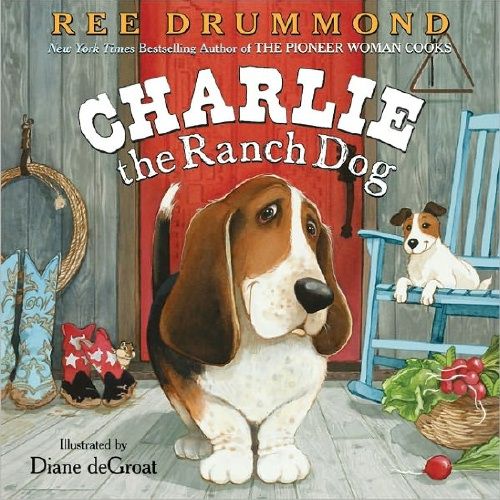
Is that bacon I smell on his breath?
Anyway, just in case you're not familiar with the book (where on the wide prairie have you been?), it chronicles a typical day on the cattle ranch from Charlie's point of view. Along with his best friend Suzie (a spunky Jack Russell terrier), he gets up too early every morning and works so hard (wink, wink) fixing fences, gardening, keeping cows and other critters in check, fishing, and rounding up cattle.
A dog this busy certainly deserves oodles of bacon a good meal and endless naps a little rest now and then just to keep his strength up. Why, if not for Charlie's steady vigilance, Daisy the cow could have destroyed the garden! Personally, I happen to admire those who've perfected the fine art of napping and bacon nipping, and I know exactly how Charlie feels: a dog's work is never done. ☺
Recently, Ree blogged about the experience of writing about Charlie (her first children's book), and I thought it would be fun to get the illustrator's side of the story. Of course I'm talking about the brilliant and talented award-winning author/illustrator Diane deGroat, who's visited with us before, and is known far and wide for the 120+ books she's illustrated (most notably her beloved self-illustrated Gilbert series).

I sent Diane a few questions and she came back with some right chewy answers and lots of photos. She's done an outstanding job with the pictures in this book, and I think you'll enjoy learning more about how she created them. How did she manage to perfectly capture Charlie's ranch-roving, bacon-loving ways, and extend Ree's trademark wry humor? Grab a biscuit, tap your boot heels together, sit and stay. Roll over if you like, but do read on. (No need to beg.)
Congratulations on the great success of Charlie and the Ranch Dog! How did you get this gig, and what did you like most about doing it?
It's true that when one door closes, another opens. I had just learned that my Gilbert series at HarperCollins was ending. I anticipated using this time to work on a proposal for a whole new series when I received an email (from a different Harper department) asking me if I'd be interested in submitting some art samples f
Blog: A Fuse #8 Production (Login to Add to MyJacketFlap)
JacketFlap tags: Harry Potter, Uncategorized, photography, NYPL, Margaret Mahy, LGBT, Diane deGroat, apps, Amulet Books, New Blog Alert, Leslea Newman, Fusenews, 2011 Awards, Hans Christian Andersen Award, Ree Drummond, Tales from NYPL, children's literature in translation, Edward Steichen, myth mistakes, New Zealand: More than just Flight of the Conchords, Add a tag
 With Book Expo going full-blast in town and my library celebrating its Centennial all at the same time, blogging is possible but slightly more difficult than usual. I am amused to find that when I skip a day some folks worry that I might be in labor. Fear not. I’ll find a way to update the blog with that news, come hell or high water. Tonight, meanwhile, is also my final Kidlit Drink Night (at least for a while) so if you’d like to view my largess (or, rather, largeness) here are the details. Meanwhile, back at the ranch . . .
With Book Expo going full-blast in town and my library celebrating its Centennial all at the same time, blogging is possible but slightly more difficult than usual. I am amused to find that when I skip a day some folks worry that I might be in labor. Fear not. I’ll find a way to update the blog with that news, come hell or high water. Tonight, meanwhile, is also my final Kidlit Drink Night (at least for a while) so if you’d like to view my largess (or, rather, largeness) here are the details. Meanwhile, back at the ranch . . .
- So I go into the administrative office the other day to pick up my room’s checks and WHAM! Two gigantic Lego statues of Patience and Fortitude (the library lions) are just sitting there, chewing their cuds (or whatever it is Lego lions chew). I showed them to a class of second graders on a tour a day or so later (they’re on display in our main hall, if you’re curious) and one kid said that looking at them was like looking at a computer screen. He had a point. They’re mighty pixilated.
- Meanwhile, my workplace also just created the app of the future. But you don’t have to take my word for it. Thanks to @DanBlank for the link.
- Wow. That’s pretty cool. The organization Keshet (“a national organization working for the full inclusion of lesbian, gay, bisexual and transgender Jews in Jewish life”) is releasing posters of LGBT Jewish Heroes. One of the posters available? Leslea Newman of Heather Has Two Mommies and my favorite LGBT board books Mommy, Mama and Me and Daddy, Papa, and Me. Thanks to Marjorie Ingall for the link.
- Do you have what it takes to take on the Sixth Annual 48 Hour Book Challenge? I don’t want to hear your excuses! I want to see you reading. You’ve some time to prep so get those eyeball stalks limbered up.
- Recently I attended SLJ’s Day of Dialog (slooooow emerging blog post to come on the subject). The keynote speech was delivered by Katherine Paterson who began, much to my delight, with some praise of New Zealand children’s book superstar Margaret Mahy (who would be a superstar here if they just friggin’ republished The Changeover *coughcough*). Anyway, it seems she recently won in the picture book category of the 2011 New Zealand Children’s Book Awards. What would you like to bet me that someday they’ll rename those awards “The Mahys”? I give it ten years, tops.
- Speaking of aw
10 Comments on Fusenews: What’s wrong with this picture?, last added: 5/26/2011Display Comments Add a Comment
Blog: The Children's Book Review (Login to Add to MyJacketFlap)
JacketFlap tags: Spring, Easter, Early Readers, Kevin Henkes, Board Books, Jeff Mack, Diane Degroat, Hans Wilhelm, Margaret Wise Brown, Ages Four to Eight: Books for pre-school to second grade, Goodie Bag: Books to share and give, Book Lists: Specialty picks, Ages Baby to Three: Books for infants and toddlers, Maryann Cocca-Leffler, Picture Book - Wordless, Lisa McCue, Seasonal: Holiday Books, Betseygail Rand, Colleen rand, Gilbert and Friends, Lexi Ryals, Sarah Emaneulle Berg, Add a tag
By Bianca Schulze, The Children’s Book Review
Published: April 4, 2011
Spring brings warmer weather, fragrant and bright colored flowers, adorable baby farm animals, and taller children. Spring also brings more books—books that encompass all of those topics and more, for our taller children with blossoming minds. It’s time to select a book that matches the tone of the season, grab a blanket and find a nice spot outside for a spring story time session.
From bunnies to eggs to butterflies to chicks and even a spring shower, these books that have been selected all harness some kind of special spring power and celebrate Easter in its secular form.
Picture Books
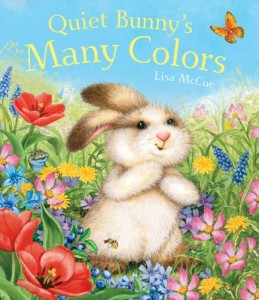 Quiet Bunny’s Many Colors
Quiet Bunny’s Many ColorsBy Lisa McCue
Reading level: Ages 4-6
Hardcover: 32 pages
Publisher: Sterling (March 1, 2011)
Source: Publisher
Hands down, the best spring book of 2011. The colors, the critters, the bugs, every illustration captures the essence of spring. The story is light and bounces with fun read-aloud words and finishes with a gentle-but-powerful message of self-acceptance. Simply gorgeous!
Add this book to your collection: Quiet Bunny’s Many Colors
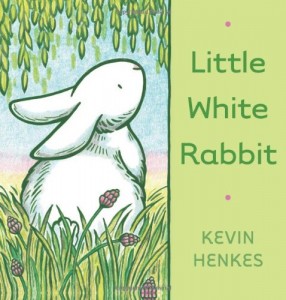 Little White Rabbit
Little White Rabbit
By Kevin Henkes
Reading level: Ages 2-7
Hardcover: 40 pages
Publisher: Greenwillow Books (January 25, 2011)
Source: Publisher
Kevin Henkes is brilliant and so is Little White Rabbit. The pastel colors of the pencils and acrylic paint give off friendly charm as the rabbit explores nature and his own abilities. The gentle details given to the rabbit’s face allow the readers to truly experience the delicate emotions experienced on every page—especially the bliss of true devotion from his mother. The double-page spread of Rabbit imagining what it would be like to flutter through the air with butterflies provides sheer elation.
Add this book to your collection: Little White Rabbit
Blog: jama rattigan's alphabet soup (Login to Add to MyJacketFlap)
JacketFlap tags: diane degroat, small graces, Add a tag

Approximately 5" x 5", original, unpublished, signed watercolor.
It's Small Graces time again!
And look, it's Gilbert!
In case you don't recognize him, he's the star of Diane deGroat's highly popular picture book series. This endearing opossum first captured our hearts in Roses are Pink, Your Feet Really Stink (William and Morrow, 1996), and eleven books later, he's still going strong with his most recent adventure, April Fool! Watch Out at School! (HarperCollins, 2009). Gilbert even has his own I Can Read books now -- have you seen Gilbert, the Surfer Dude (HarperCollins, 2009)? Let's just say, interesting things happen when you go to the beach and forget your bathing suit. ☺


Looks like Gilbert is in a bit of a funk with that rain coming down. I'm sure he'll feel much better if you place a bid! All proceeds from the Small Graces auctions benefit The Foundation for Children's Books, a small non-profit that sponsors author and illustrator visits and residencies for under-served schools in the greater Boston area. Quite a win-win situation -- your money goes to a good cause, and you have a chance to own some original art by one of the country's premier, award-winning children's book author/illustrators!
Besides creating the Gilbert series, Diane has illustrated well over a hundred books in her long, illustrious career. She was the very first person I ever interviewed for alphabet soup, and you'd be hard-pressed to find anyone warmer or more generous. We love you, Diane!
The auction runs all this week -- so click on over to Ebay and place your bid! Gilbert told me he wants to go home with you! ♥
P.S. Here's the perfect book to read this week for Mother's Day:

Hope you're having a good week!!
Copyright © 2010 Jama Rattigan of jama rattigan's alphabet soup. All rights reserved.
Blog: jama rattigan's alphabet soup (Login to Add to MyJacketFlap)
JacketFlap tags: interviews, diane degroat, reviews and musings, Add a tag

Diane with her collaborator, Shelley Rotner.
Woof woof! Hot diggety dog!
I'm pleased as punch today to welcome back supremely talented and prolific author/illustrator Diane deGroat, who has totally gone to the dogs with fellow author Shelley Rotner to create a thoroughly delightful, tickle your funny bone picture book, Dogs Don't Brush Their Teeth.
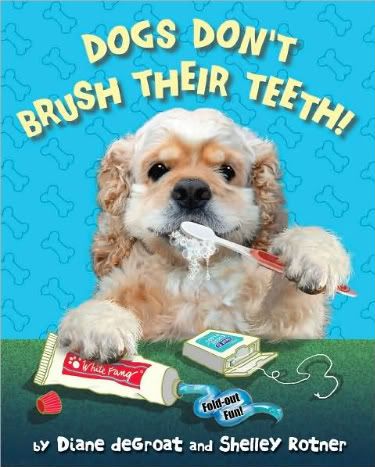
Picture book for ages 4-8, 32 pp.
Just released by Orchard/Scholastic on August 1st, this fold-out concept book combines photographs with digital art to illustrate what dogs do, and what they don't do, and has readers of all ages howling with laughter and begging for more.
You don't have to be a dog lover to appreciate these charismatic canines, who, thanks to Shelley's expert photography and Diane's clever Photoshop manipulations, can be seen doing fun things like playing tennis, eating with a knife and fork, playing in a rock band, and of course, brushing their teeth (with White Fang toothpaste, no less). The fold-out format is highly effective at keeping the suspense and surprise padding along at a good clip with nary a whimper. And if all this adorableness isn't enough, the acknowlegement page features all the dogs' names and breeds with their profile pictures. Yip!
Some of you may remember that Diane was my very first alphabet soup interviewee back in October 2007, when she stopped by to talk about the snowflake she had created for the Robert's Snow auction. That's when we all found out about this: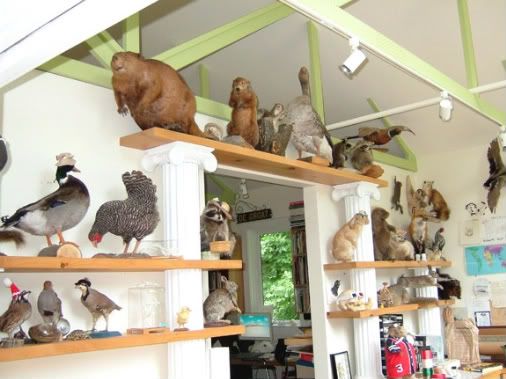
Yes, Diane's famous taxidermy collection! Quite fascinating, no? Since then, Diane has published two more titles featuring everyone's favorite possum, Gilbert, in addition to the new dogs book. So, why did Diane have to remove the canine's canines? And what other tricks did she and Shelley perform for these perky posable pups?
Sit. Stay. Read on:
Such a pleasure to have you back, Diane. How did you and Shelley come to work together on this project?
Shelley Rotner and I became friends when I moved to MA and joined the Western Massachusetts Illustrators' Guild in 1995. Shelley always had good ideas, and I was anxious to try something different from my usual picture book art. We planned a brainstorming session to find a book idea that could combine her photographs with my art. With pad and pencil in hand, we tossed a lot of ideas around. We both agreed that dogs were a good subject, but we weren't on the same page with it.
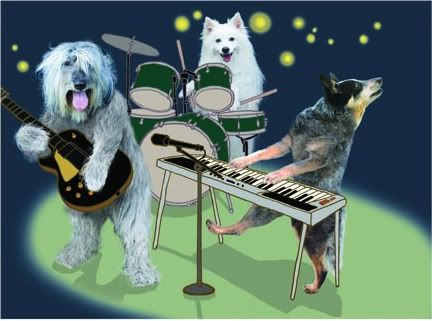
Late into the night (and after a good bottle of wine), I was still pushing for a picture book story about a lost dog, which had the potential for some interesting artwork, but the story kept falling flat. Shelley was leaning toward a concept book, as most of her books are nonfiction. Finally, Shelley came up with the "dogs do, dogs don't" idea. It sounded almost too simple, but when we started making a list of what dogs do, and the human equivalent of what they don't do, it really took shape. That was the fun part -- coming up with silly ideas. The rest was hard work!
Was this the first time both of you had worked on something like this?
It was my first collaboration, and it was Shelley's first book that was "silly," rather than serious.
How did you make the illustrations?
I made the full-sized dummy art by drawing right into my computer with my Wacom tablet. I had to figure out the best way to position the dogs in the illustrations. They had to work with the flaps closed (Dogs do . . .), and with the flaps opened (Dogs don't!). Shelley photographed the dogs as close as possible to my sketch, but of course she couldn't shoot a dog blowing a bubble or using a hula hoop!
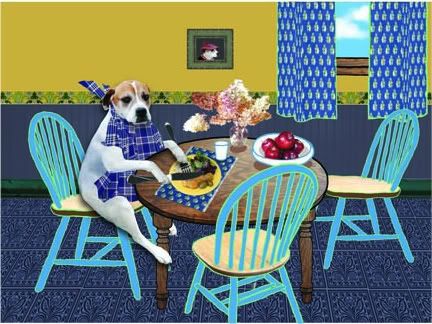
That's when Photoshop came in. I had to manipulate the photograph to look like the dog was performing a human action. Sometimes I used pieces from many different photos to do this. The harder part was figuring out what the background art should look like. There were many ways I could have handled it: collage-y, scribbly, cartoony or realistic. I had to try many different styles until I found the one that I was most comfortable with.
Do you have a favorite picture? Which one took the longest/was the most difficult?
My favorite illustration, and one of the hardest, is the dog with the braces on his teeth. I spent almost a week getting the teeth to look right!
Here's the dummy sketch with the flap opened:
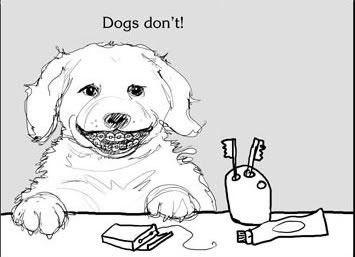
This is the photograph that Shelley took:

I scanned canine teeth from an animal anatomy book:
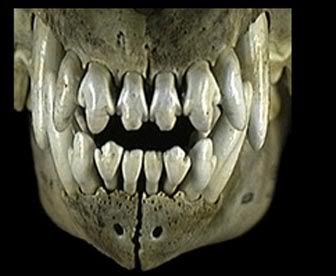
I placed them in the Cocker Spaniel's mouth. Then I drew over the teeth and added gums. I had to guess how they would fit, and what the smile would look like! I'm sure any veterinarian looking at this would cringe at its inaccuracy!

It looked really creepy, so I shortened the canine teeth and closed the mouth some:

I Googled an image of braces. Then I drew over one to make it clearer: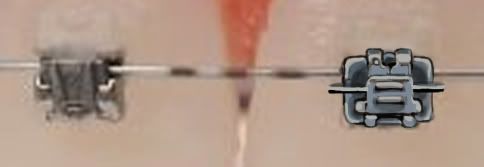
I then copied and pasted it onto each of the teeth, and added the wires.

Then I tried different backgrounds.
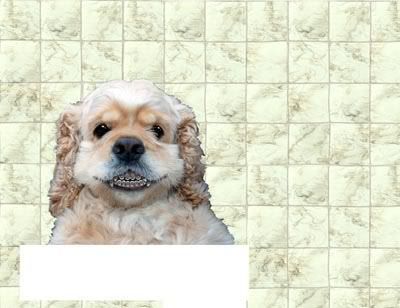
The paws came from a different dog.
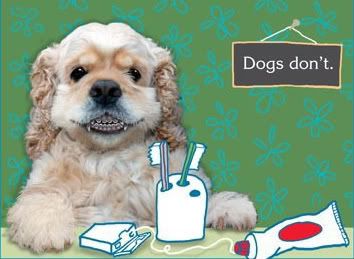
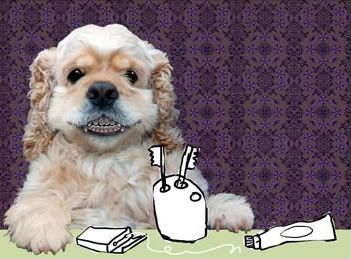
At this point, the cartoony style of drawing in the above art didn't feel right, as it was too great a contrast with the photograph. I made the drawing more realistic in the final version below, and the toothbrush was replaced with a photograph. Shelley thought the purple Victorian wallpaper in the background looked too formal; she suggested using bones instead. I drew the bones onto the background, and I agree that it looks much better. And finally, the canine teeth were removed altogether. Even though it's not anatomically correct, it doesn't look as creepy!
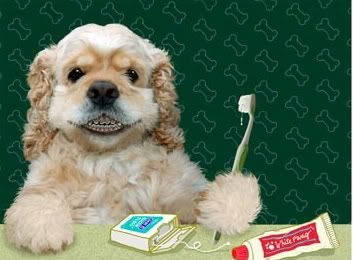
What were some of the most notable things you learned from working on this book? Any tips for other illustrators who might be interested in combining photographs with digital art?
This was my first collaboration, and it took some getting used to. But it paid off: neither Shelley nor I could have done this book by ourselves, so a collaboration really worked in this case. Artistically, I learned to take risks and to try new things that I would never have attempted with watercolor. With digital art, you can't mess up your work, so trial and error is a great way to go. I also had help from other illustrators who work more with digital art than I do. Their expertise was invaluable when I ran into a technical problem. And sometimes our illustrator's group was a good venue for suggestions and comments.
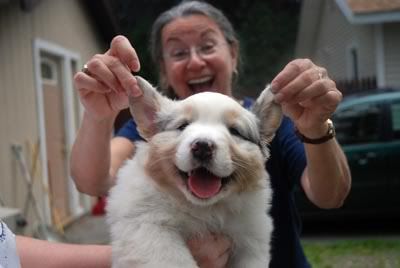
How were the dogs chosen?
Shelley had an Australian Shepherd, Ginger, who sadly passed away while we were working on this book. While walking Ginger in town or on the trails, Shelley met many other dogs and their owners. She was also acquainted with breeders and she had friends who owned dogs. There never seemed to be a lack of dogs to photograph! We tried to use breeds that best fit the activity, such as using a greyhound for the "running" art, and a bulldog for the eating scene.
Did Shelley have any especially funny/challenging/memorable incidents occur when she was photographing them?
The dogs were sometimes given treats to get them to pose. If a dog moved, or if the lighting was poor, the photo would be out of focus. They had to be shot outdoors where there was enough light, but not in the sun, which would cause strong shadows. Weather was always a factor! The owners were eager to help whenever possible. If you check the outtake slides on the website, you'll see some of the owners trying to position their dogs for Shelley. One of the hardest dogs to photograph was the pooping dog. Shelley had to follow the dog around until just the right moment!

Please tell us all about the Dogs Don't Brush Their Teeth website.
We made the website because we had a lot to share about the making of the book and about the dogs themselves. For the site, we gave each dog a profile page with his stats -- best friend, favorite toy, likes and dislikes, etc. It gives the reader a chance to see that the dogs in the books are real dogs. There are book-related activities for kids to download, too. And dog biscuit recipes!
What are you working on now?
Right now, I'm working on the 13th book in the "Gilbert and Friends" series. It's for Earth Day, and Gilbert's issue is his inability to come up with ideas (for a project). The title is a long one: Ants in Your Pants, Worms in Your Plants! (Gilbert Goes Green), (HarperCollins, 2011).
And of course we are thinking of a sequel to the dog book -- cats!
Before you go, please tell us about the new Gilbert titles that were released this year.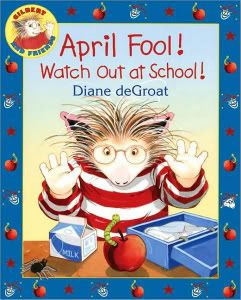
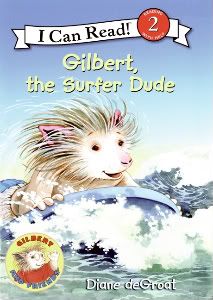
April Fool! Watch Out at School! is a little different because it has a gimmick. There are hidden "tricks" in the art that the reader has to find. (Hint: The picture of George Washington on the classroom wall is a portrait of me!) And Gilbert, The Surfer Dude is my first I Can Read book for HarperCollins. I'm running out of holidays for Gilbert's picture books, so I started a spin-off series that will cover Gilbert's everyday adventures. The second I Can Read book will be Gilbert and the Lost Tooth (2011). Again, the issues covered in these books are things that every first grader can relate to.
Thanks so much for visiting today, Diane. And thanks for writing such wonderful books! Ruff ruff!

ROLL OVER AND CLICK:
Dogs Don't Brush Their Teeth Website: You'll love all the dog profiles, process pics and downloads. You can also purchase prints, mugs and t-shirts featuring some of the illos from the book.
Booksigning Alert: Diane and Shelley will be signing books on Martha's Vineyard this weekend. Click here for their appearance schedule.
Diane deGroat Official Website.
Shelley Rotner Official Website.
Must-watch video interview with Diane over at Just One More Book: take a look at her studio and watch her draw and paint with the computer.
Online review of Dogs at Jen Robinson's Book Page.
*Spreads and photos posted by permission, copyright © 2009 Diane deGroat and Shelley Rotner, published by Orchard Books/Scholastic. All rights reserved.
Blog: A Patchwork of Books (Login to Add to MyJacketFlap)
JacketFlap tags: Gloria Whelan, Picture Book Saturday, Diane deGroat, Leslie McGuirk, Add a tag
Some new books you you all this weekend...enjoy!
Yuki and the One Thousand Carriers, written by Gloria Whelan and illustrated by Yan Nascimbene, gives us readers a bit of cultural history blended with a nice story of a young girl named Yuki. In the 17th and 18th century, provincial governors in Japan had to travel between two cities, a distance of 300 miles, which required a caravan of between one thousand and three thousand attendants (carriers), making the journey truly a huge event. Yuki's father is one of those governors and though reluctant, Yuki must accompany him and her mother on the long journey, said to be leaving her teacher and her home, writing haikus along the way.
In the 17th and 18th century, provincial governors in Japan had to travel between two cities, a distance of 300 miles, which required a caravan of between one thousand and three thousand attendants (carriers), making the journey truly a huge event. Yuki's father is one of those governors and though reluctant, Yuki must accompany him and her mother on the long journey, said to be leaving her teacher and her home, writing haikus along the way.
Written on a subject not often found in picture books, this title would be a nice selection to accompany a unit on Japanese history. Probably best suited for slightly older readers, though younger children can certainly enjoy the story and beautifully done illustrations without having to understand the backstory.
Yuki and the One Thousand Carriers
Gloria Whelan
32 pages
Picture Book
Sleeping Bear Press
9781585363520
April 2008 Wiggins Learns His manners at the Four Seasons Restaurant is written by Leslie McGuirk and Alex von Bidder and is very reminiscent of the "Tucker" books, also by the pair (and they were adorable, so that's a good thing).
Wiggins Learns His manners at the Four Seasons Restaurant is written by Leslie McGuirk and Alex von Bidder and is very reminiscent of the "Tucker" books, also by the pair (and they were adorable, so that's a good thing).
Wiggins is a Lab puppy that simply does not have proper manners. His owners aren't quite sure what to do until they are told to take Wiggins to a puppy class, guaranteed to rid him of his manner issues. Where is this puppy class? Well, at the Four Seasons Hotel of course!
Mcguirk writes quirky little stories with adorable dogs and the illustrations are quaint and sweet. Wiggins may also teach your little ones some manners too...always a plus!
Wiggins Learns His Manners at the Four Seasons Restaurant
Leslie McGuirk and Alex von Bidder
32 pages
Picture Book
Candlewick
9780763640149
August 2009
I LOVE Diane deGroat and she and Shelley Rotner have come up with this hilarious quirky book that is definitely giggle-inducing (and not just out of your kids!). Dogs Don't Brush Their Teeth! is a compilation of hilarious photographs featuring fifteen different dogs, showing just what they can do and what they can't. We have photos of a dog that can fetch a stick, but can't play baseball. One that can can howl at the moon, but can howl in a rockband. This is some funny stuff!
Dogs Don't Brush Their Teeth! is a compilation of hilarious photographs featuring fifteen different dogs, showing just what they can do and what they can't. We have photos of a dog that can fetch a stick, but can't play baseball. One that can can howl at the moon, but can howl in a rockband. This is some funny stuff!
Paired with interactive foldout pages, this one is going to be a great choice for some silly time!
Dogs Don't Brush Their Teeth
Diane deGroat and Shelley Rotner
32 pages
Picture Book
Orchard Books
9780545080644
August 2009
Blog: A Patchwork of Books (Login to Add to MyJacketFlap)
JacketFlap tags: James Howe, Mo Willems, Diane deGroat, Add a tag
The easy reader genre is not one that I get to work with a lot. They don't make great story time read alouds, just because of their length, and I don't have any children/nieces or nephews of the easy reader age group. I do, however, have some favorites that I've reviewed and plan to keep around until until I do have a little one of my own to share them with.
Those would be: The "Houndsley and Catina" books, written by James Howe and illustrated by Marie Louise Gay. My favorite is probably Houndsley and Catina and the Quiet Time, but a new one, Plink and Plunk, just came out and is also really cute.
The "Houndsley and Catina" books, written by James Howe and illustrated by Marie Louise Gay. My favorite is probably Houndsley and Catina and the Quiet Time, but a new one, Plink and Plunk, just came out and is also really cute.
Houndsley is a cute hound dog and his best friend Catina is an adorable cat. Together they help to exhibit kindness, understanding, and friendship, with some great giggles thrown in. They're great starter books for new readers and younger kids will love the illustrations, making them a pretty all-around-good book series. Of course, I just HAVE to mention the "Elephant & Piggie" books by Mo Willems. I've reviewed several on this blog and a new one came out recently, Watch Me Throw the Ball. These books are just hilarious...the best part probably being the expressions drawn on the faces of both Elephant and Piggie when something doesn't go their way.
Of course, I just HAVE to mention the "Elephant & Piggie" books by Mo Willems. I've reviewed several on this blog and a new one came out recently, Watch Me Throw the Ball. These books are just hilarious...the best part probably being the expressions drawn on the faces of both Elephant and Piggie when something doesn't go their way.
You have to be a great storyteller to get your kids to understand the sarcastic undertones and subtle humor, but when when they do get it, it's SO worth it. Love these!Finally, infamous Diane deGroat has great easy reader books featuring Gilbert the opposum, the latest being Gilbert, the Surfer Dude. I love deGroat's illustrations and her plots are also cute, but not "cutesy" appealing to both boys and girls.
Gilbert is another of those super-positive book characters, like Arthur or Biscuit, that kids love to see in a series and these easy readers are the perfect format to continue to exhibit Gilbert adventures.
To learn more about any of these titles, or to purchase, click on the book covers above to link to Amazon.
Blog: Just One More Book Children's Book Podcast (Login to Add to MyJacketFlap)
JacketFlap tags: Diane deGroat, Alicia Padron, interview, News and Notes, Add a tag
Thank you to Alicia for notifying us that there was a problem playing the Interview with Diane deGroat on our website. The issue has been confirmed as fixed (thanks, again, to Alicia).
If you missed the interview with Diane deGroat, be sure to go back and listen to it.
Blog: jama rattigan's alphabet soup (Login to Add to MyJacketFlap)
JacketFlap tags: diane degroat, mother's day, peaches on toast, Add a tag
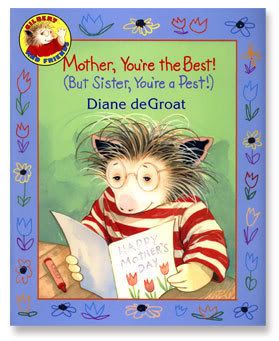
MOTHER, YOU'RE THE BEST! (BUT SISTER, YOU'RE A PEST!),
by Diane deGroat (HarperCollins, 2008), 32 pp., ages 4-8
Back in October, I interviewed children's author/illustrator Diane deGroat as part of Robert's Snow: Blogging for a Cure. We had a lot of fun talking about her taxidermy collection, and she showed us how she created one of the pictures for her newest book about Gilbert the possum, Mother, You're the Best! (But Sister, You're a Pest!).
Published by HarperCollins and released this past March, this 11th title in the wildly popular Gilbert and Friends series of picture books (appropriate for ages 4-8), finds Gilbert longing to please his mother with a special gift. After burning the toast, spilling the cereal, and drenching his Mother's Day card in orange juice, Gilbert takes breakfast upstairs to Mother, but his younger sister, Lola, is already there. He is jealous of Lola sitting on Mother's lap, so he offers to take Lola to the store.
As the day unfolds, Gilbert ends up giving Lola a bath, and then reading to her at naptime -- both attempts to keep Lola from absorbing all of Mother's attention. At the end of the day, he discovers to his surprise that he has given Mother the gift she wanted most of all -- some time to herself. And to sweeten the pot, he finally gets what he's longed for all day -- some time alone with her.
This story is endearing and heartfelt without being saccharine, and expresses well an older sibling's longing for one-on-one parental attention. Buoyant watercolor illustrations draw the reader into Gilbert's warm, cozy world of home, school, and neighborhood. A lovely addition to home or school libraries!
I asked Diane to share a favorite childhood recipe, and she sent me this:
PEACHES ON TOAST
Wonder bread
margarine
fresh peaches (very ripe)
sugar
1. Peel and cut peaches into large chunks, removing pits and any brown spots. Place in a bowl and sprinkle with sugar. Let sit until the sugar is dissolved and syrupy.
2. Spread margarine onto both sides of bread. Fry until browned and greasy.
3. Spoon some peaches over the hot bread, and eat it with a knife and fork.
**This recipe is also included in Writers in the Kitchen, compiled by Tricia Gardella (Boyds Mills Press, 1998). Diane offers this preface:
My mother regarded cooking as an unnecessary evil. Rheumatic fever in her childhood left her without a sense of smell or taste, which was helpful when changing diapers for five kids, but did nothing for the subtleties of food preparation. Her own personal diet consisted of Velveeta cheese with Ritz crackers and Pepsi spiked with Port wine; supper for the rest of us was usually hot dogs and burnt french fries, or meat loaf made from ground beef and oatmeal. Period. I know we had salt in the cabinet -- we used it to melt ice on the front steps, but if we had anything like garlic or basil, it never found its way into the meat loaf.
Sometimes she made something delicious, like peaches on toast. It appeared whenever the market had a run on overripe peaches, which were free. I've made it with whole grain bread and Pam instead of margarine, but the original is still better.

Visit Diane's website for a full list of all her wonderful books, and if you missed it, check out the in-depth interview.
Blog: Cheryl Rainfield: Avid Reader, Teen Fiction Writer, and Book-a-holic. Focus on Children & Teen Books (Login to Add to MyJacketFlap)
JacketFlap tags: ergonomics, evoluent mouse, Kinesis keyboard, anti-RSI, ergonomics for bloggers, ergonomics for writers, RSI, ergonomic keyboard, ergonomic mouse, repetitive strain injury, Add a tag
Do you spend a lot of time on your computer? I do. Between typing in my manuscript (the writing, and then all the editing changes), working on my blog or website, writing book reviews, doing online research, surfing, and even playing the odd computer game, it’s a LOT of time. And it’s so easy for me to get caught up in the work that I’m doing, and ignore my body.
A few years ago, I started to get numbness and tingling pain in my arms. Yep–the symptoms of Repetitive Strain Injury (RSI). Not a good thing. That really scared me, since I need my hands to write, to type, to do art. So I decided to research the subject. I then bought a few tools which, after using them, completely took away the pain and numbness in my arms and wrists, so now I swear by them. I also decided to try to take regular breaks–something that’s very hard for me to do.
Here are the products that I use and I highly recommend to keep your body in good shape while working on the computer:
 The Kinesis Advantage Keyboard. I really believe this ergonomic keyboard saved my arms and hands. I researched ergonomic keyboards thoroughly before I purchased this one; many keyboards that are advertised as ergonomic aren’t actually ergonomic. The Kinesis keyboard is. It’s more expensive than many others, but it works. It took away the pain and numbness in my arms, and allowed me to type easily, pain-free.
The Kinesis Advantage Keyboard. I really believe this ergonomic keyboard saved my arms and hands. I researched ergonomic keyboards thoroughly before I purchased this one; many keyboards that are advertised as ergonomic aren’t actually ergonomic. The Kinesis keyboard is. It’s more expensive than many others, but it works. It took away the pain and numbness in my arms, and allowed me to type easily, pain-free.
The one I use, Kinesis Advantage USB, may take some getting used to at first, as the keyboard is contoured, with a separate key well for each hand, which are there to reduce the strain and force you use, and position your arms in an ergonomic position, at shoulder width and with your wrists straight. Once you get used to the keyboard (I had no problems at all), it’s incredibly comfortable and easy-to-use. Any time I’m at a friend’s house and try their regular flat keyboard, I think how awkward and not-well-suited for hands it is, and wish for my Kinesis one.
The Kinesis’ keys are placed for the optimum ease of your fingers; some of the most often used keys (such as “Enter”, “Space”, “Backspace”, “Delete”) are placed in thumb keypads, allowing you to use your thumbs (which are stronger), instead of your overworked and weaker little fingers. There are a lot more ergonomic benefits to this keyboard; you can read about them here.
The Kinesis Advantage keyboard allows both the standard Qwerty layout, and the less-often used but more ergonomic Dvorak layout–AND the keyboard shows both sets of layouts. This is a nice feature; if you use Dvorak, you don’t have to just use it by memory. I decided to switch to theDvorak layout, since it’s better suited for hands. It rearranges the keys so that the ones used most frequently are located on the home row, minimizing finger movement and helping you type faster. It took me a few weeks to retrain myself to type using a Dvorak layout instead of Qwerty, but I’m happy I did.
I have been using my Kinesis keyboard for about three years, and nothing will make me turn back to a regular keyboard. Kinesis has great customer support.
The Kinesis keyboard may seem pricey at $299 US, or $329 US for the Kinesis Advantage keyboard with the Qwerty/Dvorak keyboard, but it’s well worth the money to protect and save your body. It helped me tremendously. I highly recommend it.
 The Evoluent Mouse. This mouse took away the stiffness and pain in my arm, hand, and shoulder that I was getting from using the mouse so much. It positions your hand so that it’s in a neutral handshake position, and the relief is almost instant! The position prevents forearm twisting, which a regular mouse creates. The Evoluent mouse is incredibly comfortable and easy to use. I feel like my hand is actually resting when it’s on the mouse.
The Evoluent Mouse. This mouse took away the stiffness and pain in my arm, hand, and shoulder that I was getting from using the mouse so much. It positions your hand so that it’s in a neutral handshake position, and the relief is almost instant! The position prevents forearm twisting, which a regular mouse creates. The Evoluent mouse is incredibly comfortable and easy to use. I feel like my hand is actually resting when it’s on the mouse.
All five buttons are placed so that your fingers naturally rest on them, and you need only use a light pressure (but still firm enough that you won’t accidentally click on them). You can program the buttons to do what you want, or leave them at their factory settings. It also has a really easy-to-use wheel, which I use to scroll through pages.
The Evoluent mouse is USB, and has infrared tracking that responds quickly and well to your movements. You can adjust the tracking speed and mouse pointer to your own preference. It is compatible with Windows, Mac, and Linux. They also have a left-handed vertical mouse for lefties.
There are a number of vertical mice out there, but after a lot of online research, I chose this one because it seems to be truly ergonomic, the best in its class, and has great user reviews. I have been using mine for about three years now, and I am delighted with it. I never want to use a regular mouse again! You can read more about the Evoluent mouse’s ergonomic benefits here. Evoluent has fantastic customer support, and they make frequent updates to the driver.
The Evoluent vertical mouse may seem pricey to some users at $80.00 US, but it’s worth every penny. You’ll feel the difference immediately. It saved my mouse arm from strain, pain, and numbness. I highly recommend it.
Break-time software can also help you to prevent RSI, or just keep your body from hurting too much. Some programs remind you to take a break from your computer at intervals that you set, and others go one step further and remind you to stretch, even showing you some stretches.

A great free anti-RSI program is WorkRave. It reminds you to take both micro breaks and longer breaks, and during the longer (”coffee”) breaks it shows you visuals of some stretches that you can do, and then suggests that you get up and walk away from your computer for the remainder of the 10 minutes. It also allows you to skip the break if you really need to keep working, or to shorten it. Breaks, micro-breaks, and reminders are all customizable; you can choose when and how often you want to be reminded. And you get the bonus of having a cute little sheep sitting in your system tray–along with feeling better in your body, and not injuring yourself. WorkRave is available on GNU/Linux and Windows.
You don’t often find a free anti-RSI program that shows you stretches, and for me, this is an important part of the program. I’m not likely (okay–I won’t at all) to do stretches without that visual reminder. You can scroll through the exercises, or skip one if you don’t like it. The exercises focus especially on areas of the body that can get stiff or ache, including hands, arms, shoulders, neck, and your eyes. It’s a great program, and it doesn’t cost you anything to use. So why not try it out?
For Mac users, there is a free program called Anti-RSI found here. I don’t use Mac, so I can’t tell you if it’s good or not, but the person who posted about it really likes it.
It’s also important to set up your office so that it’s ergonomic–your keyboard, your desk, your monitor…. You can get some great tips here.I hope this gives you some ideas on how to protect your body, keep yourself healthy, and prevent RSI.














 0 Comments on 2nd set of free activity sheets from authors and illustrators – Summer 2012 as of 8/9/2012 5:09:00 PM
0 Comments on 2nd set of free activity sheets from authors and illustrators – Summer 2012 as of 8/9/2012 5:09:00 PM




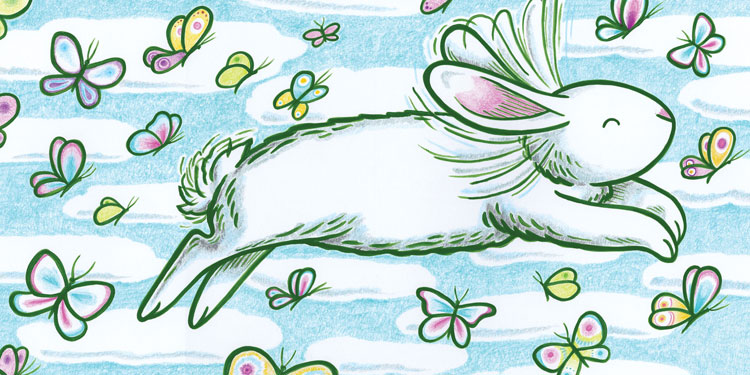
I know what’s wrong with that ridiculous picture. I mean, with good feta and Greek olives, no way is that only 230 calories. Absurd! Thanks for sharing…..
Sometime you’ll have to tell us what it was like to write a picture book, ma’am, because although the Pioneer Woman had a lot of fun, that seems too … easy…
Aw, Greg, you caught on right away. There’s no getting past you!
And yeah, as I say it’s not exactly an instructional how-to-make-a-picture-book post so much as a long and lengthy bit of praise of Diane deGroat. Which, to my mind, the world needs more of.
I enjoyed reading about Ree’s picture book experience, but it’s the veeeery rare author who gets to “write the art”! Usually, the illustrator is left in peace to proceed with his/her own creative process once the manuscript has been passed along. In fact, the editor tends to protect that process from potentially meddling, non-artist authors!
Wait – are you pregnant?
Oh, great, now I’m blind.
Lenny Kravitz was excellent in Precious. I think you’ll find he makes a perfect Cinna.
I am so looking forward to Mother Reader’s 48-Hour Book Challenge! In fact, I think you have the right idea, and I will have to practice up during the upcoming 3-day weekend.
I had to laugh at that quote about it being good toddlers not having a say in book choice. Both of my kids when they were toddlers certainly made their opinions on books known. They would close them, sit on them, hide them if they didn’t like them. They would take them out of my hands and replace them with books they did like. And neither of my kids liked Goodnight Moon.
My older son’s favorite book for a long stretch when he was a toddler?
Get Your War On.